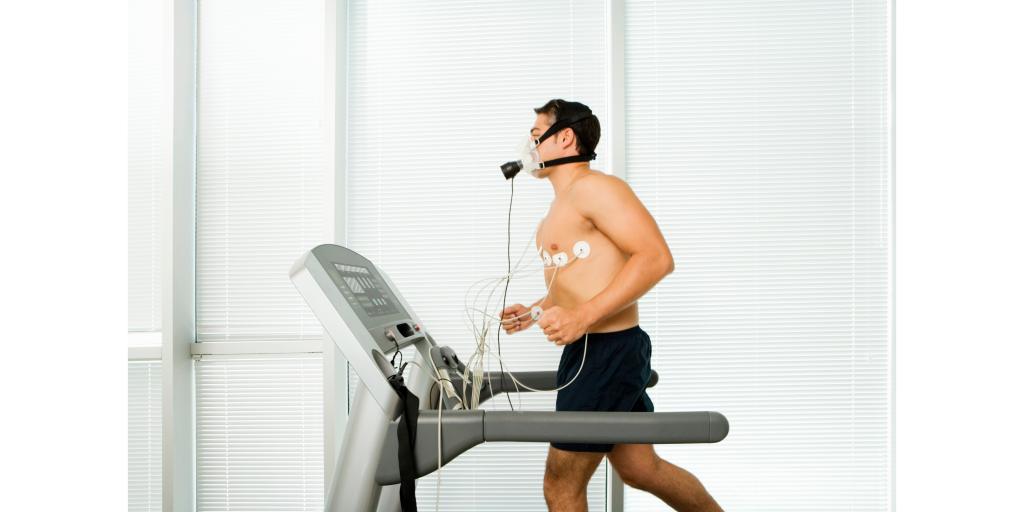By: Thalia Kaylyn Averil
Cardiopulmonary Exercise Testing (CPET) is a diagnostic technique used to assess the functional abilities of patients. CPET measures a person’s capacity to exercise and provides information about how the heart and lungs react to it. This test can help in creating a therapy and rehabilitation plan that suits the patient. Apart from that, CPET can also provide various information about the processes underlying disease in the heart and lungs. The heart and lungs are related organs because they influence each other.

Figure 1. Cardiopulmonary Exercise Testing (CPET).
Data collected during CPET includes electrocardiogram (EKG) results, heart rate, amount of oxygen (O2) absorbed, and amount of carbon dioxide (CO2) produced. Ventilations per minute and maximum oxygen consumption (VO2 max) can be calculated from the collected data so that health workers can evaluate the patient’s overall cardiopulmonary function. CPET has potential for use in the evaluation of postoperative recovery, diagnosis of various cardiopulmonary diseases, preoperative risk assessment, and general assessment of patient exercise capacity.
CPET is useful as a diagnostic tool for various cardiopulmonary related diseases because it can provide a lot of information about the body’s physiological systems. Indications for use of CPET are as follows:
- Determine the cause of limited physical exercise
- Evaluate functional status
- Assess risks for surgery
- Predict the outcome of a specific disease process
- Create a specific exercise schedule for the rehabilitation program
There are many applications for cardiopulmonary exercise testing in clinical settings. It is used to detect suspected heart and lung disease and the severity of the disease, evaluate exercise capacity, assess the risk of planned surgical procedures, and identify the cause of unexplained shortness of breath. Additionally, CPET is used to map the progression of a disease or assess treatment, detect exercise-induced asthma, assess physical fitness, and evaluate the status and treatment of heart and lung diseases. It can also be applied to evaluate surgical conditions or the effectiveness of rehabilitation programs. CPET is a useful diagnostic tool for a number of cardiopulmonary disorders, as well as for determining exercise capacity and monitoring the response of the heart and lungs to exercise.
CPET can provide many benefits for athletes, especially for evaluating the integrated function of the heart, lungs, blood vessels, and muscles during exercise. Other benefits include:
- CPET helps customize optimal exercise programs by providing detailed information, such as hemodynamic profiles, gas exchange during exercise, and the volume of oxygen uptake achieved at the anaerobic threshold.
- CPET helps differentiate between normal adaptation and potential disease occurrence in athletes, such as early cardiomyopathy. By assessing exercise physiology, limitations or abnormalities that affect an athlete’s performance can be identified.
The first step in CPET is a pulmonary function test, such as spirometry. During the procedure, the heart and lungs during exercise will be continuously monitored, providing the data needed for clinical decision making. Data describing how the heart and lungs react to exercise is collected continuously and averaged over 20 to 30 second intervals to get comprehensive information. CPET allows direct analysis of inhaled and exhaled oxygen and carbon dioxide, as well as measurement of gasses exhaled with each breath. Air flow transducers can be used to measure the volume of air inhaled and exhaled. Exercise is usually done on a treadmill or stationary bike. Higher resistance may be provided by either modality to reflect the patient’s body performance over time. Maximal oxygen consumption is 5% to 20% higher in patients using a treadmill than in patients using a bicycle ergometer because the treadmill engages more muscle groups. Additional equipment includes computers, gas analyzers, as well as screens that display 12-lead ECG analysis and exercise-induced physiological changes.
The following are things you can do before undergoing the procedure. These guidelines can vary slightly between laboratories, but the following are standard guidelines:
- Wear loose and comfortable clothing, as well as shoes suitable for running, walking, or cycling.
- Avoid exercising on the day of the examination.
- On the day of the examination, eat lightly and preferably abstain from eating anything for three to four hours before the test.
- Try not to consume caffeine on the day of the examination.
- Avoid smoking on the day of the examination.
- If you are taking medication regularly, please bring a list of the medications you are taking. On the day of the examination, it is generally recommended to consume all your regular medications, but sometimes the inhaler must be stopped.
CPET can also be a screening tool used to detect or determine the severity of suspected heart and lung disease. CPET is a useful diagnostic tool for a number of cardiopulmonary disorders, as well as for determining exercise capacity and looking at the response of the heart and lungs to exercise. If you want to have your heart and lungs screened, Cardiopulmonary Exercise Testing (CPET) is available at Abdi Waluyo Hospital.

Figure 2. Cardiopulmonary Exercise Testing (CPET) at Abdi Waluyo Hospital.
Resources
- Razvi Y, Ladie DE. Cardiopulmonary Exercise Testing. [Updated 2023 Apr 24]. In: StatPearls [Internet]. Treasure Island (FL): StatPearls Publishing; 2024 Jan-. Available from: https://www.ncbi.nlm.nih.gov/books/NBK557886/
- Albouaini K, Egred M, Alahmar A, Wright DJ. Cardiopulmonary exercise testing and its application. Postgrad Med J. 2007 Nov;83(985):675-82. doi: 10.1136/hrt.2007.121558. PMID: 17989266; PMCID: PMC2734442. Available from: https://ncbi.nlm.nih.gov/pmc/articles/PMC2734442/
- American Thoracic Society. Cardiopulmonary exercise test (CPET) [Internet]. New York: American Thoracic Society; 2020 [cited 2024 Feb 20]. Available from: https://www.thoracic.org/patients/patient-resources/resources/cpet.pdf
- Triantafyllidi H, Birmpa D, Benas D, Trivilou P, Fambri A, Iliodromitis EK. Cardiopulmonary exercise testing: the BAC for the clinical cardiologist. Karger [Internet]. 2021 Oct 14 [cited 2024 Feb 20];47(1):62–71. Available from: https://karger.com/crd/article/147/1/62/822323/Cardiopulmonary-Exercise-Testing-The-ABC-for-the
